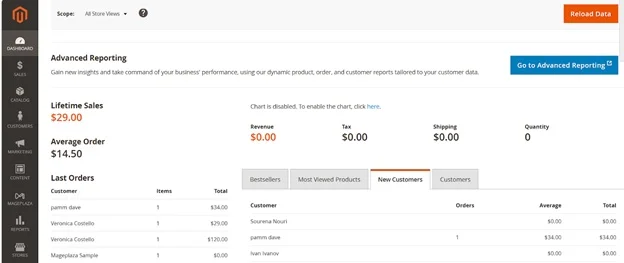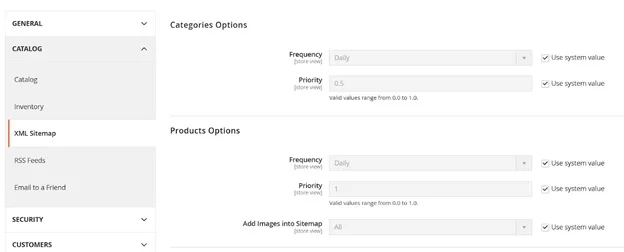For every new eCommerce business in the process of choosing an eCommerce platform, Magento is among the first on the list. According to Webtribunal, over 250,000 sites use Magento.
Yet, when it comes to a small business, there are some factors to consider, like a limited budget and resources, a small team of specialists, a high workload, and often a lack of experience. Hence, the perfect platform for such a business would be one that is simple, secure, scalable, provides clear and efficient support, and doesn’t require much maintenance.
In the article, we describe the features of Magento that make it an excellent option for small eCommerce businesses. Apart from that, you’ll find some tips on using the platform most effectively. Remember that if you face any issues, you can hire professional Magento developers.
Scalability
You should be ready for the business to grow. When it happens, you’ll need to swiftly adapt your website accordingly. Since it’s self-hosted, your website can grow right alongside your booming business. Whether you’re a small startup or a massive corporation, Magento’s got your back. Think of it this way: you might kick off with just a few products, but Magento lets you keep adding… and adding… and adding. So, in the long run, putting your trust in Magento is like betting on your business’s bright future.
That’s not easy, that’s true. But with the right help from experienced Magento developers, for example Onilab, you can expand your business to new markets, countries, and audience segments.
Customization
One of Magento 2’s standout features is its extensive customization capabilities. This allows small businesses to tailor their online stores according to their unique needs and preferences without too much effort. Let’s have a look at what exactly you can customize with Magento:
Customizing the Frontend
- Themes: Magento 2 has a plethora of themes available, both free and premium. You can modify these themes or create a bespoke theme from scratch.
- Layouts: Use XML layouts to adjust the structural components of a page. Modify headers, footers, or any other block as needed.
- Templates: Modify or override PHTML template files to alter the display of content.
- CSS & JavaScript: Fine-tune the appearance and behavior of your site using CSS and JS customizations.
Customizing the Backend
- Modules: In Magento 2, features and functionalities are encapsulated in modules. You can create custom modules or modify existing ones to enhance or add functionalities.
- Plugins: Use plugins to modify or extend the behavior of core functions without changing the core code.
- Preferences: Override core classes by defining preferences in your module’s di.xml file.
- Database Adjustments: Modify the database by adding new tables or altering existing ones using declarative schema or install scripts.
Magento 2 API Customization
- Magento 2’s Web API allows for integration with third-party applications. You can customize these APIs or add new ones to suit integration requirements.
Safety
Making sure a website is secure may appear quite difficult to eCommerce newbies. Luckily, Magento offers ready-made security solutions. Both Adobe Commerce and the community editions shield websites against viruses and possible threats. Any owner using one of these versions may use reCAPTCHA and two-factor authentication by Magento to secure their online stores, schedule security checks, and get real-time security upgrades.
Apart from that, there’s a Magento security center ready to provide all the data. The owners of the stores may learn about security updates, fixes, and best practices. With Magento, stores may also get PCI compliance and SSL certifications.
User-Friendly Interface
Another vital aspect for small businesses is ease of use. A complicated interface can be a deterrent to both business owners and customers. Magento, understanding this critical aspect, has invested in creating an interface that balances power with simplicity:

Screenshot taken on the official Mageplaza website
- Intuitive Navigation: The Magento admin dashboard is designed with clarity in mind. Essential functions like order processing, product listing, and customer management can be accessed with just a few clicks.
- Responsive Design: The admin dashboard is optimized for various devices, allowing store owners to manage their business using tablets or smartphones.
- Customizable Grid Views: Store managers can customize the data grids in the admin panel, enabling them to see the most relevant data first.
- Easy Product Uploads: Adding products, whether single or in bulk, is streamlined with guided steps.
- Visual Merchandiser: A drag-and-drop interface allows easy sorting and positioning of products within categories.
- WYSIWYG Editor: The “What You See Is What You Get” editor simplifies content creation and editing, allowing users to see real-time changes.
- Page Builder: Introduced in later versions of Magento, the Page Builder feature enables drag-and-drop content editing, making it easier for users to design and structure their content without coding.
- Integrated Reporting: The platform offers comprehensive reporting features with visual charts, making it easier to interpret data related to sales, customers, and products
Large Community
According to Meetanshi, the official Adobe Magento Forum has over 470,000 members.
The Magento community, which consists of a sizable and active community of users, developers, and professionals who are enthusiastic about the platform and committed to helping others, is one of its main advantages.
Businesses may access a wide spectrum of skills, from developers and designers to marketers and company owners, thanks to the Magento community. From creating websites to developing them, you can locate some of the top Magento web development services with ease.
To assist companies in getting the most out of the platform, the community offers free help and resources, including forums, manuals, and tutorials.
Aside from that, it’s a great chance for companies to network with others, which promotes innovation and growth.
Cost Efficiency
There are three versions of Magento:
- A free Magento Open Source edition.
- Magento Commerce with official Magento support and indicating platform usage fees.
- Magento Commerce Cloud with Amazon Web Services as the hosting solution.
Magento Open Source is the finest alternative for small to medium-sized enterprises, even if it is the simplest option. The platform allows for significant customization and flexibility, allowing you to add new features via a variety of extensions.
Magento Open Source is entirely free. This is only one of the reasons why businesses favor this version so much. The developer community also provides regular updates, and any detected security flaws are immediately remedied. Because of this, Magento Open Source is among the most cost-effective and secure eCommerce platforms.
SEO Friendliness
SEO is the foundation of online visibility, and having a prominent position in search engines is essential for digital retailers. Powerful features of Magento may generate unlimited traffic, ensuring visits from many sources, including search engines. As a result, Magento ensures an SEO-friendly website.
The ability to build URLs, meta descriptions, tags, product descriptions, XML and HTML sitemaps, and all other vital SEO elements are provided by Magento for eCommerce. Simply put, Magento makes it possible for shops and their items to appear on SERPs. Apart from SEO, it supports traffic generation from social media.

Screenshot taken on the official Mageplaza website
Extensions and Third-Party Integrations
Businesses may use Magento to incorporate any third-party plugins, extensions, and add-ons. The use of APIs can also be used to provide specialized integration with outside software.
Your platform will be able to conduct transactions securely thanks to these connectors. Additionally, the extensions improve the style and look of your website. Adobe carefully double-checks all extensions and service providers to ensure high quality. Among the tools you can integrate are:
- Payment gateways. Customers of these service providers are sent to safe payment channels to complete the transaction. The services on Magento eCommerce websites also support on-site payments. PayPal, Braintree, and Authorize.Net are a few examples.
- Shipment fulfillment. These remedies make order fulfillment chores simpler. Online retailers may set delivery costs and specify their terms and conditions using Magento’s shipping solutions. Among some popular solutions are FedEx, UPS, DHL, etc.
- Customer Relationship Management (CRM). Magento can be seamlessly integrated with leading CRM systems like Salesforce, HubSpot, and Zoho CRM. These integrations help sync customer data, purchase histories, and marketing campaigns for better customer relationship management.
- Enterprise Resource Planning (ERP). These integrations, like SAP, Oracle, Microsoft Dynamics, and others, provide real-time syncing of product information, inventory levels, order data, and customer details.
- Product Information Management (PIM). PIM integrations like Akeneo or Pimcore allow merchants to centralize and manage product information and distribute it across multiple sales channels seamlessly.
- Marketing and analytics. Integrate Magento with platforms like Mailchimp, Klaviyo, or Dotdigital to automate email campaigns, segment audiences, and personalize marketing efforts. Integration with Google Analytics, Adobe Analytics, or similar tools provides insights into customer behavior, site performance, and conversion metrics.
- Social media and advertising. Platforms like Facebook and Instagram can be integrated for selling directly through social media channels. Solutions like Google Ads or third-party retargeting platforms can be integrated for optimized ad campaigns and customer retargeting.
- Point of sale (POS) systems. For businesses with physical storefronts, integrating POS systems ensures inventory, sales, and customer data are consistent both in-store and online.
- Customer support and chat. Integrate solutions like LiveChat, Zendesk, or Tawk.to, allowing real-time customer support directly from the website. Also consider integrating a ticketing system for managing and resolving customer queries.
- Marketplaces. Magento can be integrated with global marketplaces like Amazon, eBay, or Walmart to streamline product listings, order processing, and inventory management across various sales channels.
Mobile-Responsive Design
According to Oberlo, 60% of shoppers consider the possibility of shopping via mobile as an important factor in brand selection. So naturally, customers want to be able to easily visit the Magento websites using a variety of mobile devices, such as smartphones, tablets, and other mobile devices.
With Magento 2’s shiny responsive design themes, developers can craft sites that look fabulous on any device, big screen or small. So, whether you’re a team smartphone or tablet, Magento 2 will deal with the task brilliantly.
Multi-Channel Management
With the Magento multi-channel solution, the retailers now have access to several commercial platforms. Magento stores give business owners the ability to connect their online shops to a variety of markets. The users can, therefore, increase their chances of being viewed. It also helps retailers to sell more.
Around 150 languages and all international payment channels are integrated with the system to allow businesses to grow internationally. Additionally, the platform gives firms access to all merchandising content management options, like content lists, store flags, repeater fields, etc.
Final Word
Apart from the multiple benefits of Magento for eCommerce businesses, you need to know about its limitations. First of all, the platform’s flexibility and vast features can make it complex to understand and navigate. Secondly, Magento is resource-heavy, which can affect its speed and performance if not optimized properly or if hosted on inadequate servers.
Besides, the vast number of extensions available can sometimes lead to compatibility issues. Sometimes they don’t play well together, causing a few hiccups here and there. Lastly, a quick heads-up: Magento Open Source won’t cost you a dime, but Magento Commerce’s got a price tag, and it might feel a bit hefty for some pockets.
For more helpful information, click here.
—
About the Author
Art Malkovich

Art Malkovich is a co-founding partner and CEO at Onilab. The company develops eCommerce websites and progressive web apps on a turnkey basis, offers store migration and UX/UI design services. Art has a profound expertise in web development, project management, and data analysis. He strives to keep the team one step ahead with a current focus on headless commerce.









